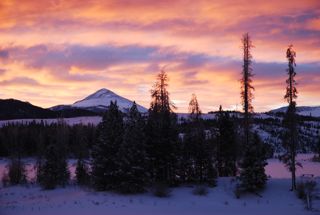 If these short days and long nights have been getting you down, don't worry — it's the winter solstice, and starting tomorrow, Dec. 22, the sun will once again start moving northward in the sky. The days will gradually lengthen toward spring, officially marked by the vernal equinox (around March 21) when day and night are equal length, and finally, the summer solstice (June 21) when the cycle starts again.
If these short days and long nights have been getting you down, don't worry — it's the winter solstice, and starting tomorrow, Dec. 22, the sun will once again start moving northward in the sky. The days will gradually lengthen toward spring, officially marked by the vernal equinox (around March 21) when day and night are equal length, and finally, the summer solstice (June 21) when the cycle starts again.
Throughout history, both the winter and summer solstice held great significance for cultures around the world. Some civilizations use great stone monuments to track the position of the sun in the sky, including Stonehenge, in Great Britain. Closer to home, the ancient Anasazi of the Southwest had their own peculiar monument, the Sun Dagger at Chaco Canyon where on the solstice, a sliver of sunlight shines between two precisely placed rocks, falling upon the center of a spiral petroglyph.
These days, many of us enjoy using bright-colored holiday lights to add a cheery glow to the long, 14-hour night. To be exact, this solstice day will be only nine hours and 22 minutes long, while the night will last more than 14 hours, with sunrise at 7:21 a.m. this morning, and sunset swiftly following at 4:43 p.m.
And sunrise will even be a little later the next few days — as late as 7:25 a.m. all the way through Jan. 11. But at the other end of the day, sunsets will also be later, each day by a bit more, so that, overall the days start to get longer. By New Years Eve, sunset will be at 4:50 p.m., about seven minutes later than on the solstice itself. If you want to track the changes, visit www.sunrisesunset.com to view or print a calendar with sunrise and sunset times. It's probably no coincidence that our modern calendar marks the start of a "New Year" about 10 days after the solstice, when the days once again become noticeably longer.
The length of the day, and the longer rhythm of the four seasons is driven by the fact that the Earth's axis is vertical in relation to the sun. It's tilted by about 23.5 degrees, so that as the Earth rotates and orbits around the sun, the angle changes ever so slightly each day. On the winter solstice, the northern hemisphere is at a maximum tilt away from the sun.
So enjoy this special day, and come back and visit us again to experience the splendor of the Rocky Mountains in every season. You can also follow us on Twitter for daily updates and join our Facebook community to stay in touch.
Filed in Colorado News |